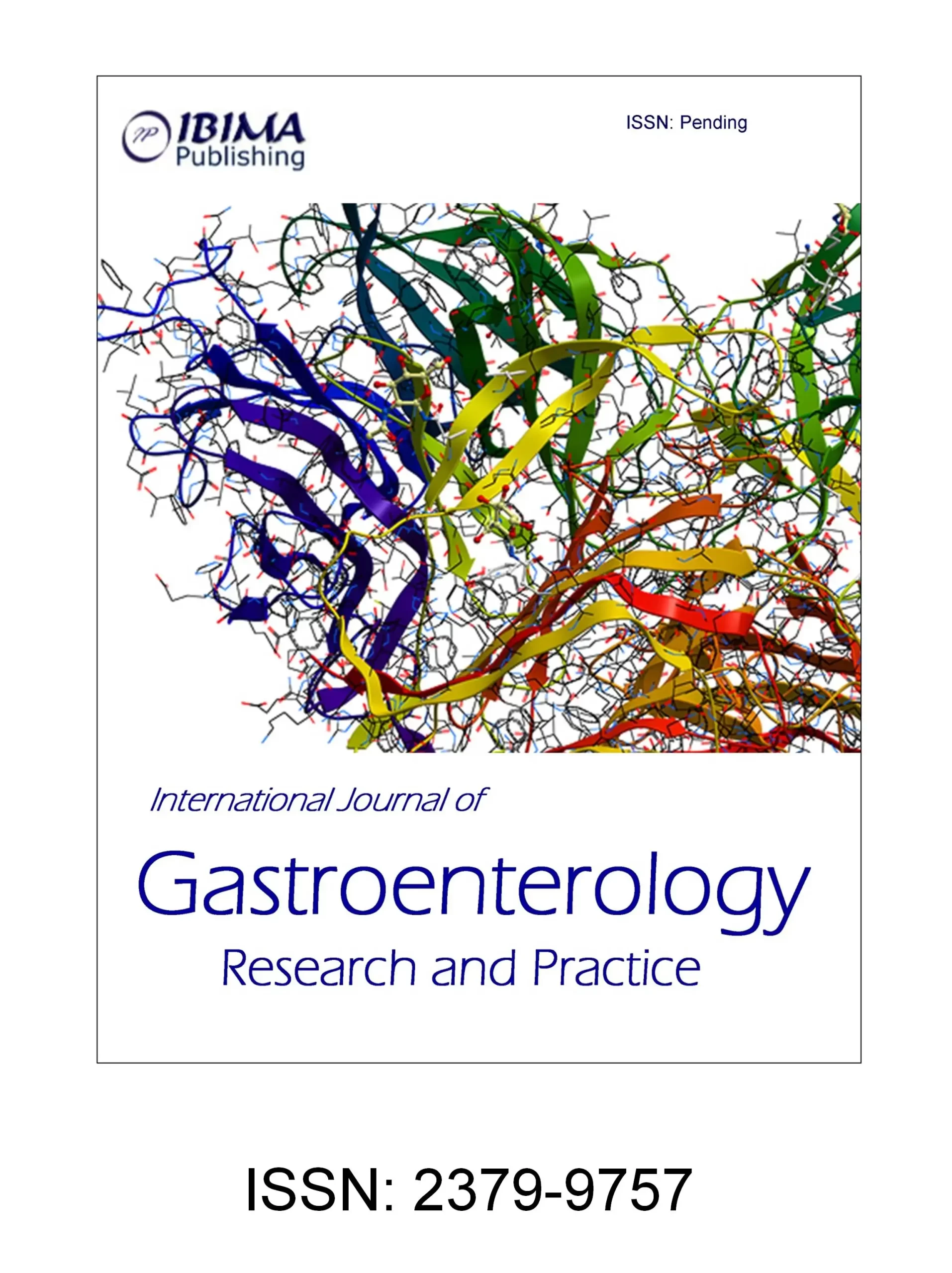Introduction
Irritable bowel syndrome (IBS) is regarded as a functional bowel disorder, which means that no identifiable pathophysiological mechanism unique to IBS has been established [1,2]. However, the results of experimental studies and clinical observations provide evidence suggesting the role of low-grade inflammation and immune activation as plausible contributors to IBS manifestations [2,3]. Previous infections and persistent mucosal inflammation are thought to play an important part in the pathogenesis of functional disorders of the digestive tract [4,5]. There are also reports of a genetic predisposition, common to patients with IBS and inflammatory bowel disease (IBD) to an increased proinflammatory response to luminal stimuli, which may suggest that signs and symptoms of IBS precede the development of IBD [6,7].
Although patients’ complaints may be indicators of inflammation and disease activity, they are obviously subjective and additionally reflect other conditions than the inflamed intestine [1,2]. The detection of intestinal inflammation in IBS patients and the assessment of its activity in fact require the use of objective diagnostic methods, which additionally should be noninvasive, simple and reliable. Quantitative measurements of biomarkers in blood serum and stool are reproducible and allow the diagnosis of the specific pathological process and the estimation of its activity, evolution and prognosis, including the prediction of the response to treatment. In clinical practice, they have the advantage of being a non-invasive diagnostic tool unlike endoscopy, provide additional clinical data, are not costly, and are easy to perform [8, 9,10,11,12].
Despite these advantages, the diagnostic role of biological markers for chronic inflammatory bowel disease which are now in use remains unclear and many authors emphasize the lack of laboratory parameters for early identification of the condition. It is commonly believed that systemic markers have low sensitivity and specificity for intestinal inflammation and correlate poorly with its symptoms and the disease activity index. Faecal markers seem superior to systemic markers because of their better organ specificity in the diagnosis of gastrointestinal diseases [6, 11,12].
IBS affects 5-11% of the population of most countries. The IBS sufferers are a heterogeneous group of patients whose clinical manifestations differ, most likely due to different underlying pathophysiological mechanisms [13].
The aim of this study was a parallel assessment of a group of acute-phase proteins ( hs-CRP, alpha-1-antitrypsin, orosomucoid, transferrin) measured in the serum and biomarkers determined in the stool (calprotectin and alpha-1-antitrypsin ) in order to establish the strongest correlation between these parameters and select a panel of laboratory measurements that reflect the inflammatory conditions in the intestine of patients with diarrhoea- and , constipation-predominant forms of IBS and alternating IBS.
Material and methods
Patients
Thirty-eight outpatients attending the Department of Gastroenterology and Metabolic Diseases, Medical University of Warsaw from 2005 to 2011 year, with the diagnosis of IBS (Irritable Bowel Syndrome) consequently based on the Rome II diagnostic criteria were enrolled in the study. The presenting complaints included abdominal pain and altered bowel habit. The patients profile is presented in Table 1.
Table 1: Profile of study subjects
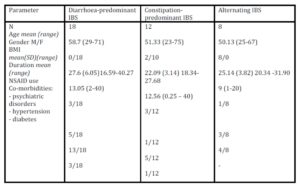
The diagnosis of IBS was made after the exclusion of infectious diseases (by faeces microbiology), coeliac disease and chronic inflammatory bowel disease (IBD). All IBS patients fulfilled the Rome II diagnostic criteria, there were no alarm symptoms such as anaemia or weight loss, the endoscopic and histologic workup as well as transabdominal sonography were normal.
On diagnosis, the subjects were subdivided into 3 groups: diarrhoea-predominant IBS (n=18), constipation-predominant IBS (n=12) and alternating IBS(n=8). The subjects were informed about the aim and design of the study and on their next visit each supplied a single stool specimen (2-5 ml) and a 3-ml blood specimen was collected from each subject for clot-based testing. The clinical material was transported to the laboratory within 3-5 hours and frozen at -20ºC.
A written informed consent was obtained from all study subjects.
Material
Blood serum was obtained after centrifuging 2-3 ml of blood collected for clot-based testing and stored for 1-9 months at – 20ºC.
Faecessupplied by each subject as a single random stool specimen in a plastic container were stored for 1-9 months at – 20ºC. Faecal calprotectin is stable against degradation up to 1 week at room temperature [14,15].
Preparation of faecal homogenate for measurements of calprotectin concentrations. After thawing of the specimen, 40-120 mg of the faeces was placed in a test tube with a tight fitting stopper containing 4.9 ml extraction buffer (novaTec Immunodiagnostica GmbH). The test tubes were shaken (Elapan laboratory shaker type 358S) for 30 minutes at room temperature. The homogenate was centrifuged for 15 minutes at 10 000 rpm (MPW-340 centrifuge). The supernatant was used to perform the measurements.
Preparation of faecal homogenate for alpha-1-antitrypsin measurements. A stool specimen was diluted 1:5 in physiological saline and shaken in a test tube with a stopper for 30 minutes (Elapan laboratory shaker type 358S). The homogenate was centrifuged for 15 minutes at 10 000 rpm (MPW-340 centrifuge). The supernatant was used to perform the measurements.
Assessment of water content in the faeces specimen. Approximately 200 mg of faeces was placed on a tared watch glass and weighed to measure the weight of fresh faeces. Next, the glass with the faeces sample was dried under 300-Watt light bulb to constant weight.
Methods
Measurements of faecal calprotectin concentrations: The measurements were performed in faecal homogenate using ELISA according to the manufacturer’s instructions for Calprotectin Test (NovaTec Immunodiagnostica GmbH).
Measurements offaecal of alpha-1-antirypsin concentrations: The measurements were performed in faecal homogenate by immunonephelometry (Dade Behring BN ProSpec System nephalometer) using rabbit antisera against human alpha-1-antirypsin (Dade Behring, Marburg GmbH), and N Protein Standard N/T Protein Controls SL, M i H (human).
Measurements of serum alpha-1-antitrypsin, orosomucoid and transferrin concentrations: The measurements were performed by immunonephelometry (Dade Behring BN ProSpec System nephalometer) using rabbit antisera against human alpha-1-antirypsin, orosomucoid and transferrin (Dade Behring, Marburg GmbH), and N Protein Standard N Protein Standard SL (human) and N/T Protein Control SL/L , M, H (human). The choice of transferrin and alpha-1-antitrypsin was dictated by different specificity and biological role of these proteins in acute phase processes.
Measurements of serumhs-CRP concentrations: The measurements were performed by immunonephelometry (Dade Behring BN ProSpec System nephelometer) using mouse monoclonal antibody (Dade Behring, Marburg GmbH), N Rheumatology Standard SL (human) and Apolipoprotein Control Serum CHD (human).
Statistical analysis
Concentrations of all study parameters are reported as a mean ± SD and a median and 95% CI. The significance of differences between the concentrations of study parameters in diarrhea-predominant, constipation-predominant and alternating IBS was assessed by the analysis of variance (ANOVA). Differences in the concentrations of the study parameters between two groups of subjects were assessed with the Mann-Whitney test. The correlations between the concentrations of study parameters were assessed with the Spearman test. The results were considered statistically significant if p values were <0.05.
Results
Mean concentrations of the study parameters and correlations between the serum acute- phase proteins and faecal calprotectin in all patients with the diagnosis of IBS (n=38) are presented in Table 2. Because of the differences in the water content of faeces between the three forms of IBS, diarrhoea-predominant, constipation-predominant and alternating diarrhoea and constipation, faecal calprotectin concentrations are expressed in μg/g fresh faeces and μg/g dry faeces.
Alpha-1-antitrypsin (AAT) was not identified in any of the faeces specimens from the study subjects. Since for AAT the limit of detection by immunonephelometry is 0.0437 g/L, AAT concentrations in the homogenates of the faeces from the study subjects must have been below this value.
Table 2: Concentrations and correlations between faecal calprotectin and serum acute phase proteins in IBS patients
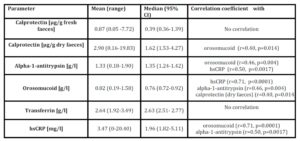
In the study subjects, significant correlations were found between positive acute-phase proteins (ORS, hsCRP and alpha-1-antitrypsin). Transferrin (a negative acute-phase protein) did not correlate with any serum protein or calprotectin. However, a positive correlation emerged between ORS and calprotectin quantified as μg/g dry faeces.
Table 3 presents serum concentrations of acute-phase proteins and faecal calprotectin levels in patients with diarrhoea-predominant, alternating and constipation-predominant IBS, including the subdivision into subjects with normal (1g/L) serum ORS concentrations.
Table 3: Increases in serum orosomucoid >1 g/l versus faecal calprotectin and serum acute phase proteins in three types of IBS
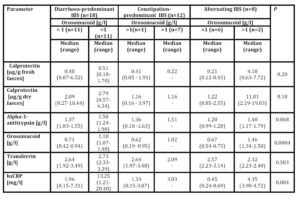
In subjects with diarrhoea-predominant IBS and ORS>1 g/L significantly increased hsCRP concentrations were observed (p=0.007).
Figure1 displays the graphical analysis of correlations between serum ORS i hsCRP concentrations and faecal calprotectin levels (μg/g dry feces) in individual subjects with diarrhoea-predominant, constipation-predominant and alternating IBS
.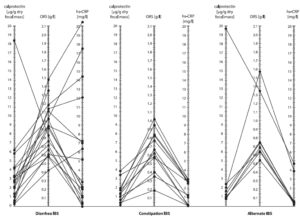
Figure 1: Graphical analysis of the relationships between serum ORS and hsCRP and faecal calprotectin in subjects with diarrhoea-predominat, constipation-predominant and alternating IBS
Faecal calprotectin higher in diarrhoea-predominant IBS vs constipation-predominant IBS (p=0.065)
Serum ORS higher in diarrhoea-predominant IBS vs constipation-predominant IBS (p=0.030)
Serum hsCRP higher in diarrhoea-predominant IBS vs alternating IBS (p=0.050).
In the diarrhoea-predominant IBS subjects, the faecal calprotectin and serum ORS were higher than in the constipation-predominant IBS subjects (p=0.065 and p=0.030, respectively). The serum concentrations of hsCRP were higher in the diarrhoea-predominant IBS subjects compared to the alternating IBS (p=0.050). Elevated hsCRP concentrations of >10mg/L (the cut-off value for the diagnosis of inflammatory conditions of different aetiology) were measured in the subjects with ORS >1g/L.
Discussion
The nature and significance of the inflammatory process in IBS remains unexplained and there may be differences in the activity of inflammation between with diarrhoea- predominant, constipation-predominant or alternating IBS. The present study assessed the usefulness of serum acute phase reactants and faecal markers determinations as non-invasive objective measurements of inflammation in these patients for potential application in clinical practice [6, 11].
Biomarkers measured in serum are not specific for intestinal disease but their elevations may reflect generalized inflammation [2, 13, 17]. On the other hand, markers determined in faeces are organ-specific and as such may prove superior in the diagnosis of intestinal inflammation. Faecal excretion of leukocytes, serum proteins and leucocyte products are such markers. Faecal indium-111-labelled leukocyte excretion is considered the gold standard although it is not suitable for use in the routine clinical practice [18,19] . Alpha-1-antitrypsin, the serum protein secreted into the intestinal lumen is an endogenous marker of intestinal protein loss, based on the assumption that owing to its anti-proteolytic activity alpha-1-antitrypsin is not modified by digestive enzymes. In the setting of mucosal inflammation, leukocyte products such as lactoferrin, myeloperoxidase and calprotectin occur in higher concentrations in the faeces. Published studies emphasize the unique role of calprotectin as a simple, cheap, noninvasive and sensitive marker of disease activity in inflammatory bowel disease and /or its response to treatment as well as the most efficient laboratory parameter for distinguishing between organic and functional intestinal disease [7,8]. Calprotectin, a 36kDa calcium- and zinc-binding protein is abundant in neutrophils, where it accounts for 60% of the protein in the cytosol, and occurs at lower concentrations in monocytes and reactive macrophages. It is released with cell death or activation, appears to play a regulatory role in the inflammatory process and has both antimicrobial and antiproliferative properties [10,11,12]. Measurement of faecal calprotectin would represent a surrogate marker of neutrophil influx into the bowel lumen and in turn act as a marker of intestinal inflammation. It correlates well with the faecal excretion of indium-111-labelled leukocytes and with the results of invasive measurements of colonic and small bowel inflammation [17, 18, 19, 20, 21].
The present study demonstrated significant correlations between the serum concentrations of acute-phase proteins (hsCRP, alpha-1-antitrypsin,ORS) in all patients with IBS, but of these only ORS correlated with the faecal calprotectin levels. The correlation the concentrations of calprotectin, ORS and hsCRP in patients diarrhoea-predominant IBS alone differentiates this type from constipation-predominant and alternating IBS. A question arises whether the selected panel of laboratory parameters may be useful in the diagnosis of low-grade intestinal inflammation in patients with diarrhoea-predominant IBS. The pathomechanism by which calprotectin occurs in the intestinal lumen is well-described and low calprotectin levels in the faeces of IBS patients observed in this study may additionally confirm numerous reports of a significant correlation between faecal calprotectin and the severity of intestinal inflammation. The cut-off value for faecal calprotecin diagnostic of IBD was established by routine clinical practice to meet the demand for generally acceptable and safe diagnostic criteria. The most commonly accepted upper limit of normal is 50 μg/g , although many authors claim faecal calprotectin cut-offs of 100 μg/g, 150 μg/g or 200 μg/g have higher diagnostic precision [1, 7, 11, 16, 20].
The hypothesis whereby low faecal calprotectin in patients with diarrhoea-predominant IBS may be associated with low grade inflammation in the intestine is confirmed by the correlation of this parameter with serum ORS.
Human orosomucoid (ORS, alpha-1-acid glycoprotein) is a glycoprotein of 41-43 kDa molecular weight, a very low PI of 2.8-3.8 and a very high content of carbohydrates, which represent 45% of the molecular weight attached in the form of five to six highly sialylated complex-type-N-liked glycans. ORS has a long half-life of 5 days. It is one of the most abundant plasma proteins (1-3% of plasma protein) and its normal plasma concentrations range from 0.6 to 1.2 g/L [22-26].
What particular biological properties make this protein found in serum a suitable marker for assessing intestinal inflammation? Its three main biological functions should be emphasized: (1) binding and transport of numerous basic and neutrally charged drugs from endogenous and exogenous sources; (2) contributing to increases in polyanionic charge selectivity of the endothelial barrier, which controls the transport of molecules, including bacteria, before they enter the circulation and are disseminated to the body organs; (3) and immunomodulatory activity associated with both pro- and anti-inflammatory effects. This double action on the immune system may confirm the important role of ORS in regulating the immune response in the course of persistent mucosal inflammatory changes in the intestine and reflect its participation in the defence mechanisms. The pro-inflammatory effect of ORS is due to its properties as a major member of the positive acute-phase protein family which increases 2- to 5-fold in amount in response to systemic tissue injury, inflammation or infection. The anti-inflammatory effect, on the other hand, is associated with inhibition by ORS of many neutrophil functions, including phagocytosis of bacteria, inhibition of neutrophil migration and superoxide production, decrease of activated platelet aggregation and inhibition of activated lymphocyte proliferation. Inhibiting of neutrophil activity by ORS is thought to be a way of decreasing a local inflammatory response and protecting tissues from damage by neutrophil proteases and reactive oxygen species. The levels of circulating ORS correlate with disease activity and are predictors of IBD recurrence [22-23, 26-28].
In the present study, a parallel increase in hsCRP>10 mg/l, which is the most commonly used marker of inflammation, was observed only in the subjects with diarrhoea-predominant IBS and serum ORS >1g/L. CRP, however, is not specific for the process of inflammation in the intestine as its levels are also increased in various viral and bacterial infections, autoimmune disorders, malignancy and other disorders resulting in tissue necrosis. In clinical practice, it is used as a marker of disease activity in inflammatory bowel disease 2, 10, 12, 15].
Summing up, at present there are no laboratory parameters in use, which are specific and sensitive enough to detect the development of low-grade inflammation in the intestine. The preliminary results of the present study suggest the potential usefulness of the correlation between low faecal levels of calprotectin and serum concentrations of ORS in patients with diarrhoea-predominant IBS as a panel of related laboratory measurements to confirm low-grade inflammation in the intestine of these patients. Increases in serum hsCRP>10mg/l in diarrhoea-predominant IBS, on the other hand, may reflect the activity of the process.
References
1.Ashorn S, Honkanen T, Kolho KL, Ashorn M, Välineva T, Wei b, Braun J, Rantala I, Luukkaala T, Itanwen S. Fecal calprotectin levels and serological responses to microbial antigens among children and adolescents with inflammatory bowel disease. Inflamm Bowel Dis 2009; 15: 199-205
Publisher – GoogleScholar
2. Törnblom H, Lindberg G, Nyberg B, Veress B, Full-thickness biopsy of the jejunum reveals inflammation and enteric neuropathy in irritable bowel syndrome. Gastroenterology 2002; 123: 1972-1979
Publisher – GoogleScholar
3. Vicario M, Alonso C, Santos J. Impaired intestinal molecular tightness in the mucosa of irritable bowel syndrome: what are the mediators? Gut 2009; 58: 161-162
Publisher – GoogleScholar
4. Parry S, Forgacs I. Intestinal infection and irritable bowel syndrome. Eur J Gastroenterol Hepatol 2005; 17: 5-9
Publisher – GoogleScholar
5. Bercik P, Verdu EF, Collins SM. Is irritable bowel syndrome a low-grade inflammatory bowel disease? Gastroenterol Clin N Am 2005; 34: 235-245
GoogleScholar
6. Tibble JA, Sigthorsson G, Foster R, Forgacs I, Bjarnason I. Use of surrogate markers of inflammation and Rome criteria to distinguish organic from nonorganic intestinal disease. Gastroenterology 2002; 123: 450-460
Publisher – GoogleScholar
7. Vieira A, Fang CB, Rolim EG, Klug WA, Steinwurz F, Rossini LGB, Candelária PA. Inflammatory bowel disease activity assessed by fecal calprotectin and lactoferrin: correlation with laboratory parameters, clinical, endoscopic and histological indexes. BMC Research Notes 2009; 2: 221-228
Publisher – GoogleScholar
8. Spinelli A. Irritable bowel syndrome. Clin Drug Investig 2007; 27: 15-33
9. Schoepfer AM, Trummler M, Seeholzer P, Seibold-Schmid B, Seibold F. Discriminating IBD from IBS: comparison of the test performance of fecal markers, blood leukocytes, CRP, and IBD antibodies. Inflamm Bowel Dis 2008; 14: 32-39
Publisher – GoogleScholar
10. Desai D, Faubion WA, Sandborn WJ. Review article: biological activity markers in inflammatory bowel disease. Aliment Pharmacol Ther 2007; 25: 247-255
Publisher – GoogleScholar
11. Gisbert JP, McNicholl AG. Questions and answers in the role of faecal calprotectin as a biological marker in inflammatory bowel disease. Dig Liv Dis 2009; 41: 56-66
Publisher – GoogleScholar
12. Iskandar HN, Ciorba MA. Biomarkers in inflammatory bowel disease: current practices and recent advances. Transl Res 2012; 159: 313-325
Publisher – GoogleScholar
13. Spiller R, Aziz Q, Creed F, Emmanuel A, Houghton L, Hungin P, Jones R, Kumar D, Rubin G, Trudgill N, Whorwell P. Guidelines on the irritable bowel syndrome: mechanisms and practical management. . Gut 2007; 56: 1770-1798
Publisher – GoogleScholar
14. Fagerberg UL Lööf L, Lindholm J, Hansson LO, Finkel Y. Fecal calprotectin: a quantitative marker of colonic inflammation in children with inflammatory bowel disease. . JPGN 2007; 45: 414-420
GoogleScholar
15. Lewis JD. The utility of biomarkers in the diagnosis and therapy of inflammatory bowel disease. Gastroenterology 2011; 140: 1817-1826
Publisher – GoogleScholar
16. D`Haens G, Ferrante M, Vermeire S, Baert F, Noman M, Moortgat L, Geens P, Iwens D, Aerden I, Van Assche G, Van Olmen G, Rutgeerts P. Fecal calprotectin is a surrogate marker for endoscopic lesions in inflammatory bowel disease. Inflamm Bowel Dis 2012; 18: 2218-2224
Publisher – GoogleScholar
17. Burri E, Beglinger C. Faecal calprotectin – a useful tool in the management of inflammatory bowel disease. Swiss Medical Weekly 2012; 142: w13557
Publisher – GoogleScholar
18. Erbayrak M, Turkay C, Eraslan E, Centinkaya H, Kasapoglu B, Bektas M. The role of fecal calprotectin in investigating inflammatory bowel diseases. Clinics 2009; 64: 421-425
Publisher – GoogleScholar
19. Schröder O, Naumann M, Shastri Y, Povse N, Stein J. Prospective evaluation of faecal neutrophil-derived proteins in identifying intestinal inflammation: combination of parameters does not improve diagnostic accuracy of calprotectin. Aliment Pharmacol Ther 2007; 26: 1035-1042
Publisher – GoogleScholar
20. Gaya DR, Mackenzie JF. Faecal calprotectin: a bright future for assessing disease activity in Crohn`s disease. Q J Med 2002; 95: 557-558
Publisher – GoogleScholar
21. Lisowska-Myjak B, Pachecka J, Sokrates O, Brzozowska-Binda A, Torbicka E. Fecal alpha-1-antitrypsin excretion in children with diarrhoea. Scand J Gastroenterol 1998; 33: 255-259
Publisher – GoogleScholar
22. Lee YS, Choi JW, Hwang I, Lee JW, Lee JH, Kim AY, Huh JY, Koh YJ, Koh GY, son HJ, Masuzaki H, Hotta K, Alfadda AA, ,Kim JB. Adipocytokine orosomucoid integrates inflammatory and metabolic signals to preserve energy homeostasis by resolving immoderate inflammation . J Biol Chem 2010; 285: 22174 – 11185
Publisher – GoogleScholar
23. Hochepied T, Berger FG, Baumann H, Libert C. α1-acid glycoprotein : an acute phase protein with inflammatory and immunomodulating properties. Cytokine& Growth Factor Reviews 2003; 14: 25-34
Publisher – GoogleScholar
24. Hochepied T, Wullaert A, Berger FG, Baumann H, Brouckaert P, Steidler L, Libert C. Overexpression of α1-acid glycoprotein in transgenic mice leads to sensitization to acute colitis . Gut 2002; 51: 398-404
Publisher – GoogleScholar
25. Theilgaard-Monch K, Jacobsen LC, Rasmussen T, Niemann CU, Udby L, Borup R, Gharib M, Arkwright PD, Gombart AF, Calafat J, Porse BT, Borregaard N. Highly glycosylated alpha1-acid glycoprotein is synthesized in myelocytes , stored in secdondary granules, and relerased by activated neutrophils. J Leukoc Biol 2005; 78: 462-470
Publisher – GoogleScholar
26. Fournier T, Medjoubi-N N, Porquet D. Alpha-1-acid glycoprotein. Biochim Biophys Acta 2000; 1482: 157-171
Publisher – GoogleScholar
27. Sörensson J, Matejka GL, Ohlson M, Haraldsson B. Human endothelial cells produce orosomucoid , an important component of the capillary barrier. Am J Physiol Heart Circ Physiol 1999; 276: H530-H534
GoogleScholar
28. Williams JP, Weiser MR, Pechet TT, Kobzik L, Moor jr. FD, Hechtman HB. α1-acid glycoprotein reduces local and remote injuries after intestinal ischemia in the rat. Am J Physiol Gastrointest Liver Physiol 1997; 273: G1031-G1035
GoogleScholar



